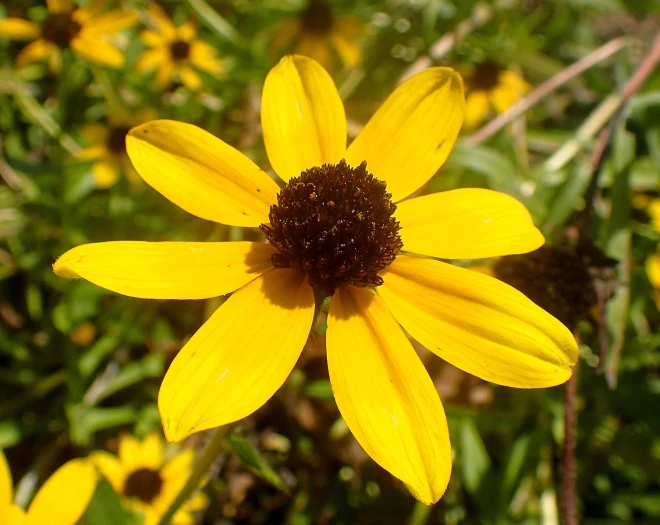Missouri Coneflower
(Rudbeckia missouriensis)
Missouri Coneflower (Rudbeckia missouriensis)
/
/

Krzysztof Ziarnek, Kenraiz
CC BY-SA 4.0
Image By:
Krzysztof Ziarnek, Kenraiz
Recorded By:
Copyright:
CC BY-SA 4.0
Copyright Notice:
Photo by: Krzysztof Ziarnek, Kenraiz | License Type: CC BY-SA 4.0 | License URL: https://creativecommons.org/licenses/by-sa/4.0 | Uploader: Kenraiz | Publisher: Wikimedia Commons |













Estimated Native Range
Climate Requirements for Rock Hill, South Carolina
| This Plant | Your Site | Plant Suitability for Your Location | ||
|---|---|---|---|---|
| • Precipitation | 31" - 55" | 48" | Aquatic | Aquatic |
| • High Temp. | 70°F - 95°F | 90°F | Your summer temperatures are normal for this plant. | Excellent |
| • Low Temp. | 11°F - 39°F | 31°F | Your winter temperatures are normal for this plant | Excellent |
This plant should grow very well at your location without additional irrigation.
Summary
Rudbeckia missouriensis, commonly known as Missouri Coneflower, is a deciduous perennial herb native to rocky glades, prairies, and open woodlands in the Central and Southern United States. It typically grows to a height of 2-3 feet (0.6-0.9 meters) and a width of 1-2 feet (0.3-0.6 meters). The plant features lance-shaped leaves and daisy-like flowers with yellow rays and a prominent, raised central cone that is purplish-brown, blooming from July to September. The flowers are highly attractive to pollinators and are quite showy, making them a favorite among gardeners and wildlife enthusiasts.
Missouri Coneflower is valued for its long blooming period and its ability to thrive in poor, rocky soils where other plants may struggle. It is often used in native plant gardens, wildflower meadows, and as a border plant. This species is drought-tolerant once established and prefers full sun exposure, though it can tolerate light shade. It is not typically plagued by serious pests or diseases, but powdery mildew and leaf spot can occasionally occur. The plant’s ability to self-seed makes it a good choice for naturalistic plantings, but gardeners may need to manage its spread if self-seeding is not desired.CC BY-SA 4.0
Missouri Coneflower is valued for its long blooming period and its ability to thrive in poor, rocky soils where other plants may struggle. It is often used in native plant gardens, wildflower meadows, and as a border plant. This species is drought-tolerant once established and prefers full sun exposure, though it can tolerate light shade. It is not typically plagued by serious pests or diseases, but powdery mildew and leaf spot can occasionally occur. The plant’s ability to self-seed makes it a good choice for naturalistic plantings, but gardeners may need to manage its spread if self-seeding is not desired.CC BY-SA 4.0
Plant Description
- Plant Type: Herb
- Height: 2-3 feet
- Width: 1-2 feet
- Growth Rate: Moderate
- Flower Color: Yellow
- Flowering Season: Summer, Fall
- Leaf Retention: Deciduous
Growth Requirements
- Sun: Full Sun
- Water: Low, Medium
- Drainage: Medium
Common Uses
Bee Garden, Bird Garden, Butterfly Garden, Deer Resistant, Drought Tolerant, Groundcover, Hummingbird Garden, Low Maintenance, Rabbit Resistant, Showy Flowers
Natural Habitat
Rocky glades, prairies, and open woodlands
Other Names
Common Names: Missouri Orange Coneflower, Brown-Eyed-Susan
Scientific Names: Rudbeckia missouriensis, Rudbeckia fulgida var. missouriensis
GBIF Accepted Name: Rudbeckia missouriensis Engelm. ex C.L.Boynton & Beadle